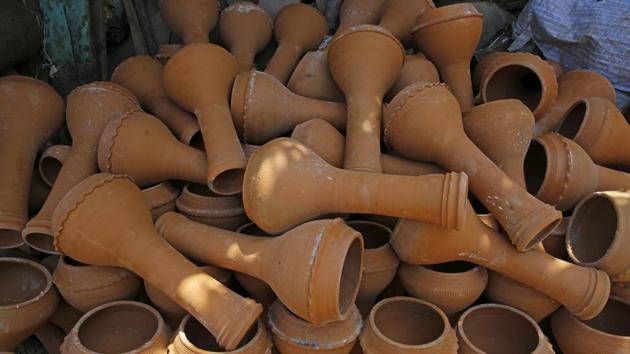
Mohammad Shahban Kumar of Chadoora, for the last three months has worked overtime to make Tumbaknaris.
Knowing that the marriage season was approaching, he made more than 4000 Tumbaknaris, a traditional musical instrument, which is a quintessential part of weddings in Kashmir.
Interestingly, all of these tumbaknaris have sold due to their immense demand during the wedding season.
“We have only a few left now. Tumbaknari are good during the wedding season since it is an essential musical instrument used during weddings in Kashmir,” he told news agency—Kashmir News Observer (KNO).
The Tumbaknari is a traditional Kashmiri drum, which is cast in a clay funnel like case. The instrument is a symbol of celebration and joy for its resonant and melodic tones.
Due to the heavy demand for Tumbakanris, the potters make up for the annual loss to their business following reduced demand of earthenware in Kashmir.
A Tumbaknaris comes in three different sizes: small, medium and large. While small is used by children, medium and large have a huge demand for its quality of sound and durability.
Its cost ranges from Rs 200-300 per Tumbakanri. “Number of Kumars (potters) is gradually diminishing in Kashmir. Those who are still associated with the pottery cash in on weddings to earn some bucks selling tumbakanris,” Kumar said.
Abdul Majeed Kumar of Baramulla said the demand for this musical instrument grows up to 80 per cent during August, September, and October.
“These three months are the peak season of marriages in Kashmir. We witness a good sale of Tumbaknaris as 80 percent of our stock gets sold. Tumbaknaris and Kangris are the only two products which keep potters hooked to the profession in Kashmir,” he said.
Majeed said Tumbaknaris in Kashmir have a good demand for all the sections of the society.
“Even those who are financially privileged and hold wedding functions in hotels too love to use Tumbaknari during wanwun (chorus wedding songs). From engagement functions to mehandi raat, Tumbaknaris continue to adorn Kashmiri weddings,” he said.
The process of making a Tumbaknari begins with the careful selection of clay, followed by shaping, firing, and intricate hand-painting. Each drum is a unique work of art, reflecting the artisan’s creativity and dedication to preserving Kashmir’s cultural heritage—(KNO)




